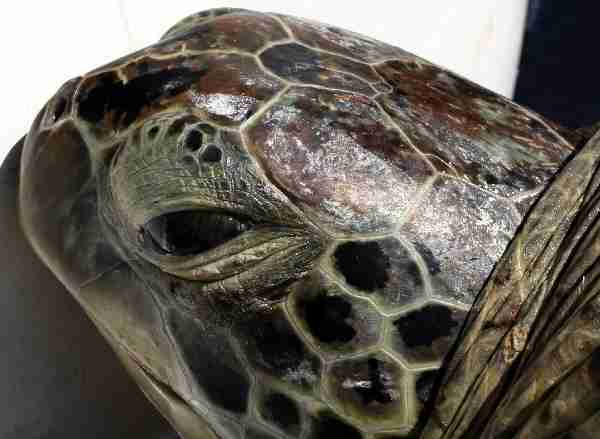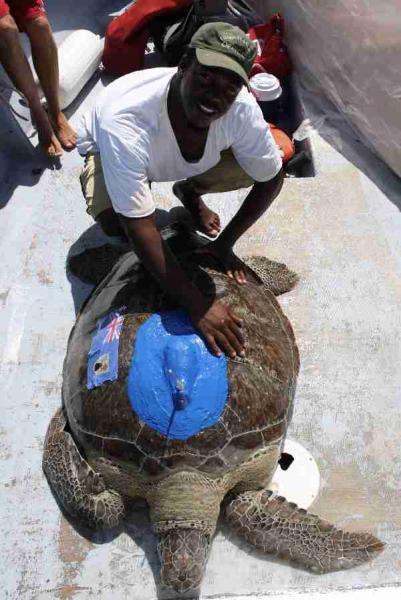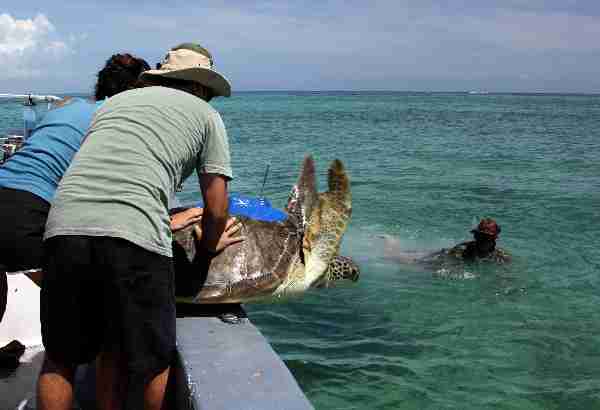Peter B. Richardson
Marine Conservation Society (MCS), Ross on Wye, Herefordshire HR9 5NB, UK. E-mail: peter.richardson{at}mcsuk.org
Presented to the BCG Symposium at the Open University, Milton Keynes, on 13th March 2010.
On the 27th January 2010, Suzie, an adult female green turtle and the first turtle to be fitted with a satellite transmitter in the Turks and Caicos Islands (TCI), returned to her feeding grounds off the north coast of East Caicos. It was the end of a 6,000 kilometre migration that took her to seven other Caribbean countries in just under five months (Fig. 1).
Fig. 1. Map of Suzie’s migration. The dotted line and arrows show Suzie’s migration path and the numbers represent the following range states: (1) Turks and Caicos Islands, (2) The British Virgin Islands, (3) Anguilla, (4) Barbuda, of Antigua & Barbuda, (5) Martinique, (6) Haiti, (7) The Dominican Republic and (8) Grand Inagua in the Bahamas.
Shortly after Suzie was tagged, a rather tragic story unfurled when, on the night of June 30th, Tommy and Amdeep successfully intercepted a nesting hawksbill during a night patrol of the beaches on Fish Cay, just south of South Caicos. After the turtle successfully nested, Tommy and Amdeep carefully attached a satellite tag to her carapace and released her, naming her Felicia after Tommy’s daughter. The team excitedly tracked her movements online, and two weeks later Felicia’s tracking data indicated that she emerged again to nest on Fish Cay. Usually marine turtles successfully nest during one to three nights of nesting attempts, but this time Felicia emerged on Fish Cay for seven consecutive nights before she finally and successfully nested during her eighth night of emergences on Big Ambergris Cay, seven kilometres due south of Fish Cay. Noting this unusual behaviour, the team continued to track her as she remained close to Fish Cay, suggesting that she would nest again, most likely some time around the 10th of August. Sadly, her tracking data on that day strongly suggested that she had washed ashore on Fish Cay. Sure enough, South Caicos fishermen passing Fish Cay the next day noticed a dead turtle on the beach and brought Felicia back to Amdeep and Tommy in South Caicos. They removed the tag and carried out a post-mortem on the carcass, which suggested Felicia had died at sea close to Fish Cay and washed ashore there. A cause of death could not be identified, and while it is not clear what caused Felicia’s demise, given the difficulties she endured during her previous nesting attempts, it may well have been linked to complications associated with egg bearing. Fortunately, with generous support from a kindly BCG member, we were able to send Felicia’s tag back to the manufacturers for refurbishment, and it is now back in the field with Amdeep and Tommy ready for deployment in 2010.
Shortly after this rather dark time for the Project, Suzie brightened the mood when, on the 1st September she finally made her move away from the TCI. She headed south-east and those following her progress had no idea where she was going or what she was doing as they watched scientific discovery unfold each day on their computer screens. By early October she had swum directly to the British Virgin Islands (BVI) and then on to Anguilla, and because these are UK Overseas Territories, as is the TCI, Suzie made the news again. Her passage through the islands was excitedly announced in the press of both the BVI and Anguilla, but her story had already travelled further than the Caribbean. In the UK, The Times hailed her as an “anglophile green turtle”, while The Daily Telegraph and The Metro newspapers respectively claimed that her journey through three consecutive UK Overseas Territories hundreds of kilometres apart had left scientists baffled and dumbfounded! The BBC’s online news pages featured more sober reporting, including photos of Suzie, a map of her journey and a link to the Seaturtle.org online tracking site. This was excellent coverage and led to the story featuring on at least 25 other online news sites from around the world.

Fig. 2. Close-up of Suzie the green turtle.
But this was merely the beginning of Suzie’s journey and she soon moved on, arriving in Barbuda’s waters on the 8th October. There she remained for two weeks and, unlike anywhere else on her route, her tracking data strongly suggested that she attempted nesting during the nights of the 17th and 18th October on the beaches of Low Bay. Intriguingly, Antiguan researchers carried out a boat-based beach survey of Low Bay a few days later. They found fresh green turtle tracks close to the emergence locations indicated by the satellite tracking data, but could not confirm whether the nesting attempt was successful. Suzie made the local press again and Antiguan bloggers claimed that because she may have nested on Barbuda, Suzie had come back to her birthplace. Her followers expectantly waited to see if she would nest again on Low Bay but, instead, Suzie left Barbuda on the 22nd October. She headed east and then south, stopping at Martinique for just five days, where she generated yet more local press coverage, before swimming west into the deep Caribbean Sea. Now her followers were truly puzzled – where was she going?

Fig. 3. Suzie and Tommy with her satellite transmitter in place.
After 24 days of swimming non-stop across the Caribbean Sea, inspiring much speculation about her final destination, Suzie took a turn northwards and eventually arrived at the south-western tip of Haiti on the 2nd December. Those in South Caicos following her journey suspected that she was now trying to get back home to TCI and predicted she would continue north-west. Surprisingly, instead of taking the more direct northwest route to TCI, she headed due east, and started swimming close inshore along the southern coast of Hispaniola. Fingers were crossed, hoping that she would survive the fishers’ nets en route, and a month later she eventually rounded the southeast tip of The Dominican Republic. South Caicos fishers talked of her imminent return, and when it looked as if she might finally be coming back to TCI, she swam west to Great Inagua, Bahamas, her eighth country en route, where she tantalisingly remained for two more weeks. Suzie finally started swimming away from Inagua on the 22nd of January, and the next day she had made it to North West Point, Providenciales, after a 145 day long journey. She spent the next four days swimming along the north coast of the Caicos Islands before arriving safe and sound off East Caicos on the 27th January.

Fig. 4. Suzie being released. Photos by Marta Calosso.
The fact that Suzie’s journey could be tracked online every day at Seaturtle.org generated unprecedented interest and enthusiasm for the project along the way, especially in South Caicos. The Amdeep and Tommy team kept residents there up to date by regularly displaying her most recent maps in bars, supermarkets, the airport and other public places around the island. They were often stopped in the street to be asked “Where Suzie at?” and seasoned TCI turtle fishers have been amazed to learn that their turtles travel so far. Some have even stated that Suzie has made them think differently about the management of their fishery.
Overcoming the earlier setback with Felicia’s tragedy, the Project team hopes to maintain this local interest through the online tracking of four other adult hawksbill turtles that have since been fitted with satellite tags and released back into the TCI’s waters. But these turtles have a hard act to follow. Suzie’s journey may be the longest satellite tracked green turtle migration recorded in the Caribbean (cf. Godley et al., 2008), a fascinating journey that not only raised the profile of her species in the region, but also raised several questions, with perhaps the most perplexing being “Did she really migrate 6,000 kilometres to lay just one clutch of eggs?”
[Adapted from an article by Peter Richardson and co-authors that first appeared in the Marine Turtle Newsletter (www.seaturtle.org/mtn) in Summer 2010.]
Acknowledgements
The Turtles in the Turks and Caicos Islands Project is a collaboration between the Department of Environment and Coastal Resources (DECR) and The School for Field Studies (SFS) in the TCI, the Marine Conservation Society (MCS) and the University of Exeter in the UK and Duke University in the USA. It is funded by MCS Ambassadors Anne and Simon Notley, the Natural Environment Research Council and the project partners. The satellite telemetry study is funded by the People’s Trust for Endangered Species and the British Chelonia Group. The authors would like to thank our colleagues in the British Virgin Islands, Anguilla, Antigua & Barbuda, Martinique and elsewhere for their generous help, information and advice offered along the way. We would especially like to thank Dr Michael Coyne for his tireless efforts working with Seaturtle.org and STAT, without which Suzie’s incredible journey would not have been so accessible to so many.
References
Coyne, M.S. & Godley, B.J. (2005). Satellite Tracking and Analysis Tool (STAT): an integrated system for archiving, analyzing and mapping animal tracking data. Marine Ecology Progress Series 301: 1-7.
Godley, B.J., Blumenthal, J.M., Broderick, A.C., Coyne, M.S., Godfrey, M.H., Hawkes, L.A. & Witt, M.J. (2008). Satellite tracking of sea turtles: Where have we been and where do we go next? Endangered Species Research 4: 3-22.
Richardson, P.B., Broderick, A.C., Campbell, L.M., Godley, B.J. & Ranger, S. (2006). Marine turtle fisheries in the UK Overseas Territories of the Caribbean: domestic legislation and the requirements of multilateral agreements. Journal of International Wildlife Law & Policy 9: 223-246.
Richardson, P.B., Bruford, M.W., Calosso, M.C., Campbell, L.M., Clerveaux, W., Formia, A., Godley, B.J., Henderson, A.C., McClellan, K., Newman, S., Parsons, K., Pepper, M., Ranger, S., Silver, J.J., Slade, L. & Broderick, A.C. (2009). Marine Turtles In The Turks And Caicos Islands: Remnant Rookeries, Regionally Significant Foraging Stocks And A Major Turtle Fishery. Chelonian Conservation and Biology 8(2): 192-207.
B.C.G. Testudo Volume Seven Number Two 2010
Top




